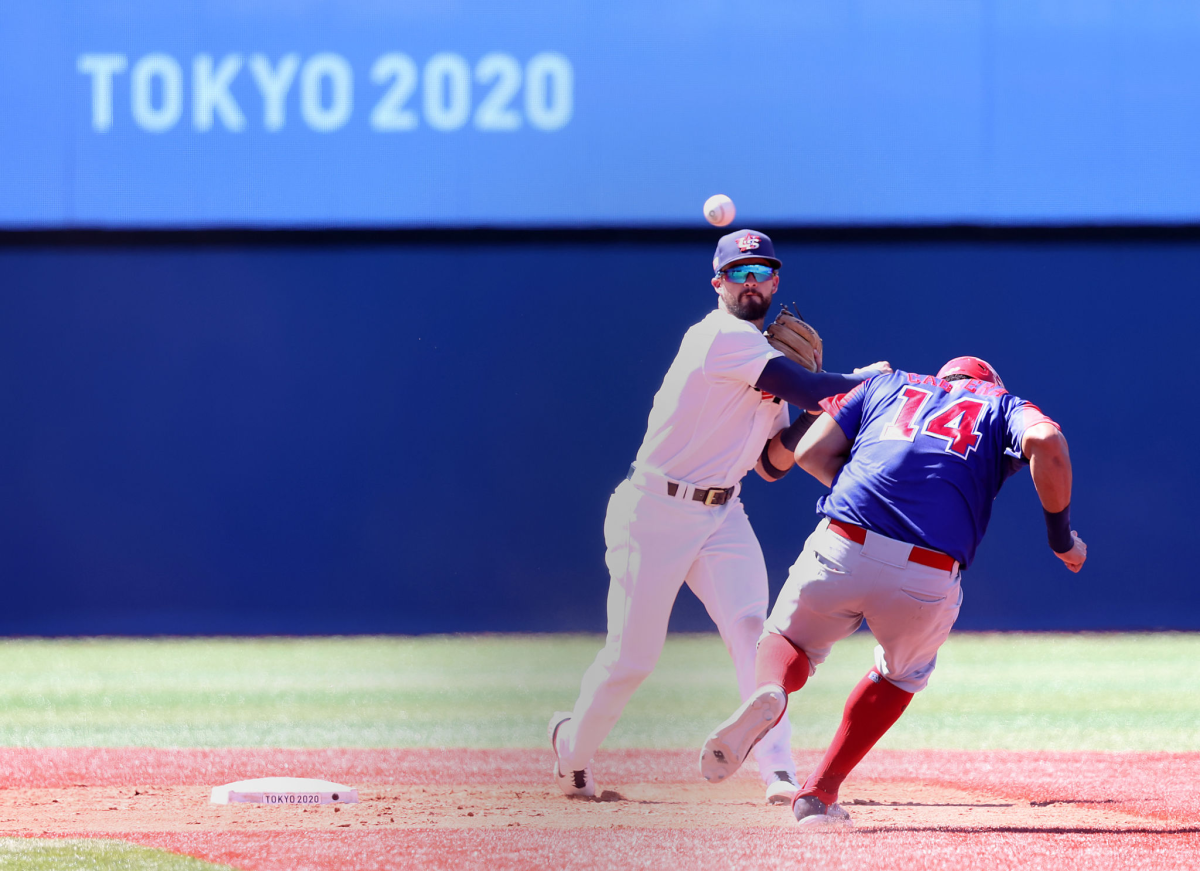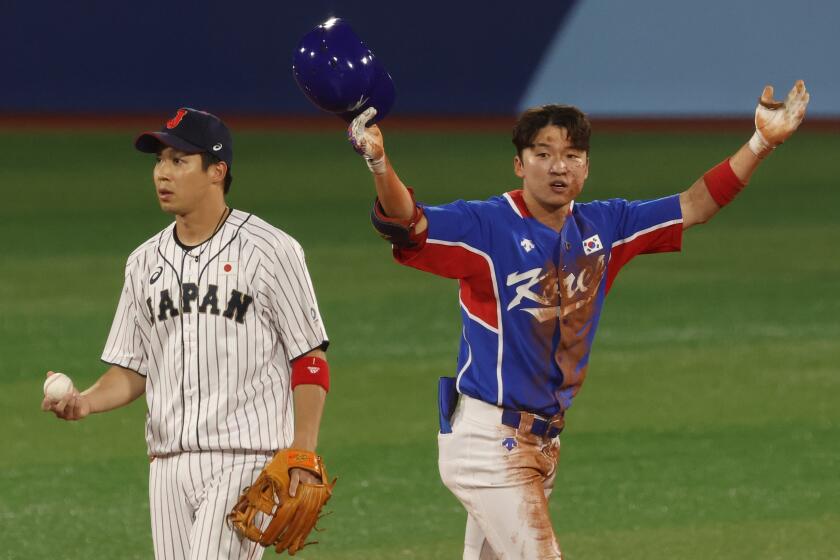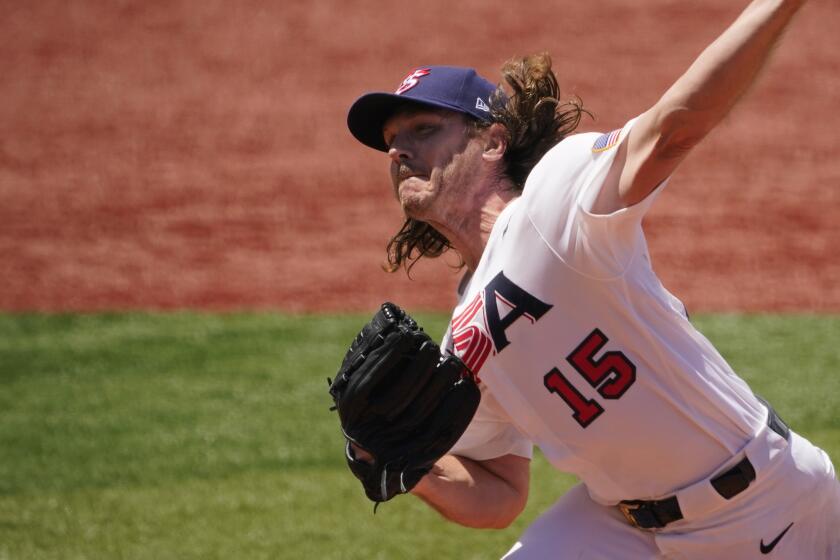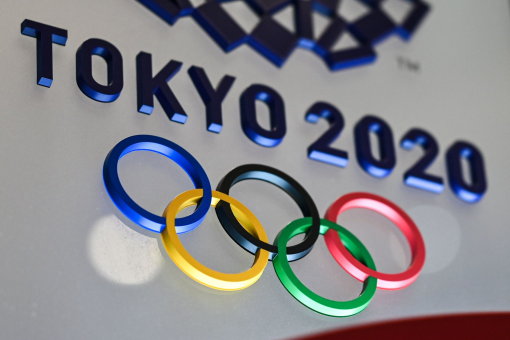‘Best baseball I’ve ever touched’: Why players love Japanese Olympic baseballs

- Share via
YOKOHAMA, Japan — The baseball tournament at these Olympics has featured bigwigs from yesteryear, prospects on the rise and Asian stars in their primes. There have been exciting introductions and emotional goodbyes, thrilling finishes and gloomy heartbreak. But the star of the show might be the most prevalent, under-the-radar component on display every day: the baseball.
“They need this ball over in America,” said Joe Ryan, a starting pitcher for the United States. “It is amazing. It’s perfect.”
The baseball used in the major leagues, according to seemingly every pitcher you ask over there, is far from perfect. It’s slick. It’s inconsistent. It’s a problem. So much so that it became accepted for pitchers to use illegal foreign substances for better grip in recent years until Major League Baseball, after negative public comments from players, determined the cheating crossed a fuzzy line.
The substances allowed for unprecedented spin rates, which increased pitch movement and made hitting more difficult. Strikeouts, subsequently, steadily rose to historic levels in recent years. MLB determined the pattern was hurting its product.
A Japanese Salvadoran American Angeleno columnist and a Korean American Seoulite walk into a bar in Tokyo’s K-Town during the Korea-Japan Olympic baseball game. . .
In March, before the regular season started, MLB sent a memo to teams communicating plans to implement increased monitoring of baseballs and to crack down on the use of foreign substances. But the league stopped short of saying it would punish pitchers. That quickly changed.
In June, the league announced it would regularly check pitchers for substances in games and eject and suspend pitchers caught with sticky stuff for 10 games. The timing — midseason with little time to adjust — drew scorn from pitchers. At least one — Tyler Glasnow — has blamed the prohibition for a significant arm injury (Glasnow tore his ulnar collateral ligament and recently underwent Tommy John surgery).
If MLB wants to look across the Pacific for a solution, they’d probably start with a phone call to Koji Yasui.
Yasui is the general manager of the baseball division at SSK, the manufacturer for the Olympic balls. The company produces 3,500 boxes of 12 balls every month for a total of about 520,000 balls in a year.

The balls are used across different levels in Japan — youth, high school, college, industrial league — and for the renowned national baseball high school championship. Mizuno produces the balls for Nippon Professional Baseball, the country’s top league.
“But there is a history of pro teams using our balls to practice,” Yasui said.
Yasui said SSK only uses Japanese cow hides prepared by Japanese tanneries — and not just because of their expertise. Japanese tanners, according to Yasui, have encountered difficulty when trying to create similar balls in China and Taiwan, and they think the water is the reason. He claimed Chinese and Korean tanneries generate unstable results even with the same methods.
It’s definitely a different baseball. If you want to compare the two, I like the SSK ball a lot better.
— Scott Kazmir, on the difference between MLB and Olympic baseballs
“It depends on the number, but it’s not like we have a huge surplus just sitting around,” Yasui said. “We’d need some advance notice. We’d also have to secure the materials. I think we’d need time to prepare to produce whatever would be asked of us.”
Yasui, who has worked at SSK for 40 years, said all the balls are the same size, the result of a meticulous assembly process with segments devoted to a specific aspect and multiple quality checkpoints. The balls come individually wrapped.
Former Dodgers pitcher Scott Kazmir held Dominican Republic to two hits over five scoreless innings in a 3-1 win for the U.S. at the Tokyo Olympics.
“It’s got this tack that they put on it before,” Ryan said. “So when you open that thing up, it’s ready to rock and roll.”
Japan’s record-setting heat and stifling humidity during the Olympics have created difficult conditions for pitchers — a few have used so much rosin that a puff of dust explodes with each pitch — but those asked said they didn’t have trouble gripping the baseball.
“It’s definitely a different baseball,” said U.S. pitcher Scott Kazmir, a 13-year major-league veteran who appeared in three games this season. “If you want to compare the two, I like the SSK ball a lot better.”
Mexico reliever Oliver Pérez, a 19-year major-league veteran, said the ball moved more than usual for him, perhaps because of the stickier grip. U.S. reliever Scott McGough, who is in his third season with the Yakult Swallows, said he didn’t see a difference in his pitch movement. He added that the rosin bag used in Japan is also better compared to the rock rosin used in the U.S.
“With a little sweat and some rosin the ball can get really sticky,” McGough said.
It’s not just pitchers raving about the balls. U.S. first baseman Triston Casas, one of the tournament’s standouts, said he liked the balls too because, effectively, they’re easier to hit.
“I think they’re a little whiter,” said Casas, who has three home runs in the Olympics. “I can see it better.”
Ryan said the balls fit in his hand more easily than those in the U.S. — both he and Kazmir said they seem smaller. He noted that several major league pitchers have asked him to bring SSK balls back to the U.S., and he offered to give the company his address for a shipment during a postgame news conference after tossing six innings in the Americans’ Olympic opener.
For now, Ryan, a 25-year-old right-hander acquired last week by the Minnesota Twins, can only campaign for a future change.
“It is — I can’t say this enough — the best baseball I’ve ever touched,” Ryan said. “Yeah, we need this.”
Times staff writer Dylan Hernández contributed to this report.
More to Read
Go beyond the scoreboard
Get the latest on L.A.'s teams in the daily Sports Report newsletter.
You may occasionally receive promotional content from the Los Angeles Times.










